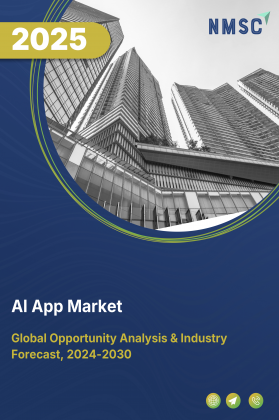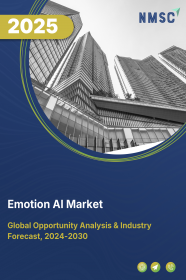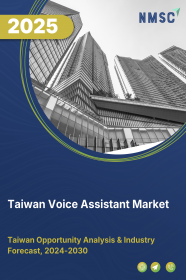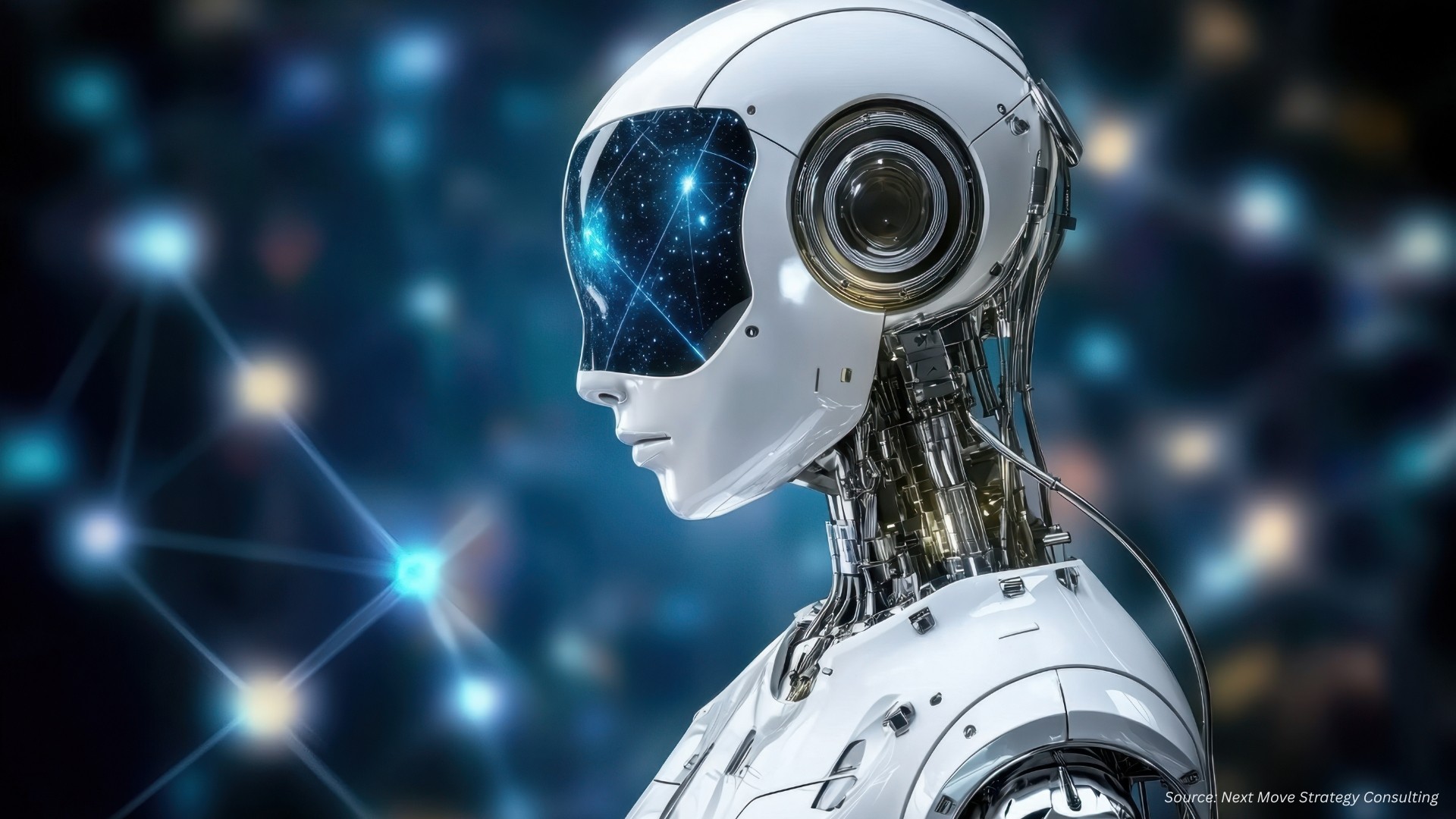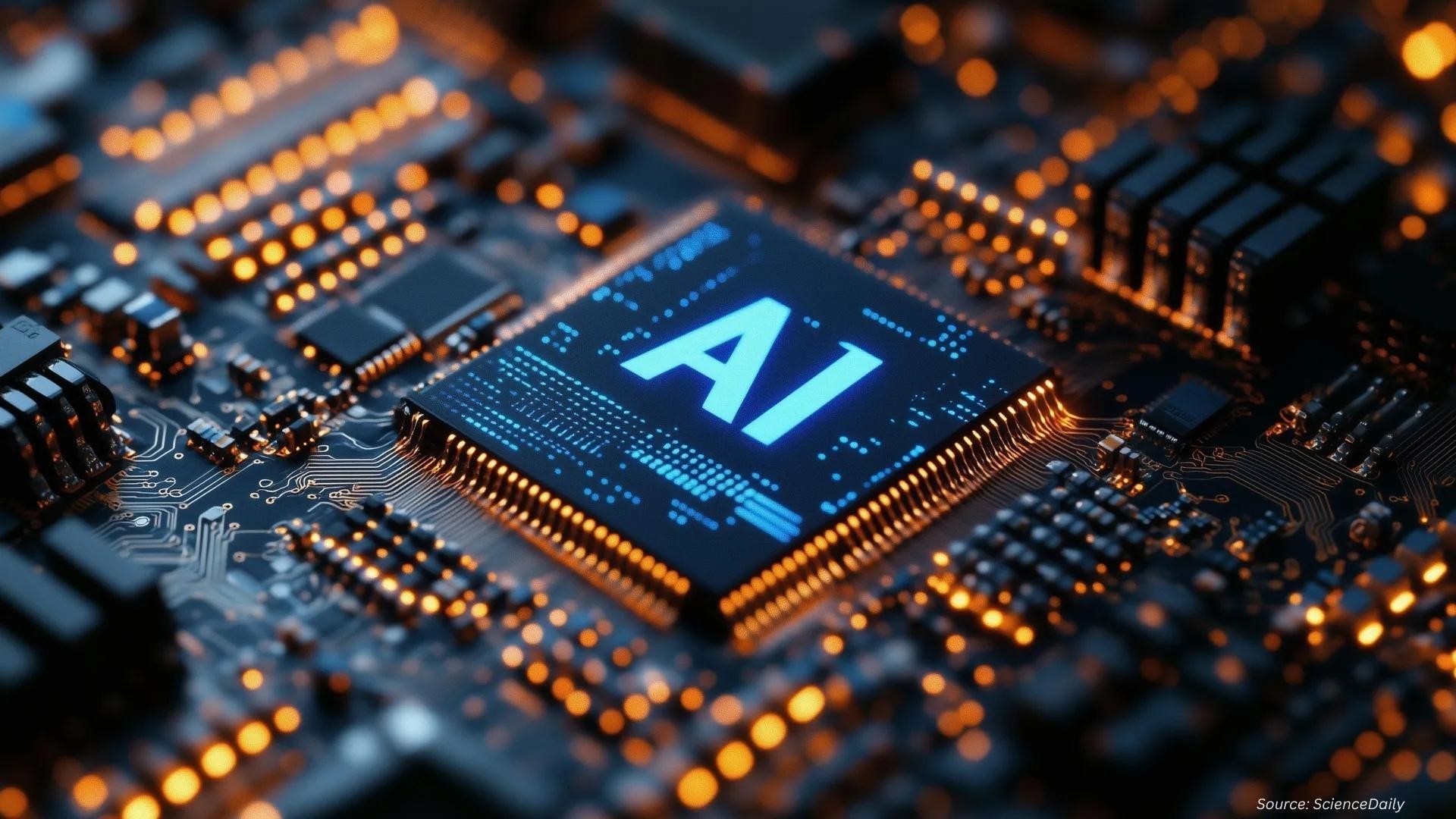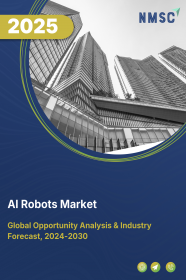
AI Robots Market by Offering (Software and Hardware), by Robot Type (Service Robots, Industrial Robots, and Others), by Technology (Machine Learning, Computer Vision, Context Awareness, and Natural Language Processing), by Deployment Mode (Cloud and On-Premises), by End-user Industry (Automotive, Retail & E-commerce, Healthcare, Food & Beverage, Military & Defense and Others) – Global Opportunity Analysis and Industry Forecast 2024-2030
Market Definition:
The AI Robots Market size was valued at USD 12.83 billion in 2023 and is predicted to reach USD 77.73 billion by 2030 with a CAGR of 28.3% from 2024-2030. AI robots are robots integrated with artificial intelligence that enables them to simulate human intelligence and perform tasks autonomously.
AI robots can make decision and solve problems faster than human as it has superior computation abilities that makes them capable of analyzing enormous amounts of data to make better decisions. AI robots uses deep learning and machine learning methods to learn and adapt without following explicit instructions. AI robots can significantly reduce errors and work with high precision as it takes decisions based on previously gathered information and algorithms.
Market Dynamics and Trends:
Increasing adoption of AI enabled robots in manufacturing industries as it can detect micro-scale defects in a production line using real-time data is driving the growth of the market. Also, increasing adoption of AI robots for personal use across the world as they are highly efficient in cleaning, carrying objects is driving the AI robots market.
For instance, as of 2021, iRobot corporation has sold more than 40 million artificial intelligence robotic systems across the world that includes iRobot corporation’s robotic vacuum knows as Roomba and robotic mop called Braava. Roomba and Braava works on iRobot’s AI-powered platform known as iRobot Genius Home Intelligence.
However, factors such as high deployment and maintenance cost of AI robots are restraining the growth of artificial intelligence (AI) robots market. On the contrary, integration of internet of things (IoT) with AI robots for better connectivity and improved interaction with the environment and humans is expected to create ample opportunities in the AI robots market in near future.
Market Segmentations and Scope of the Study:
The AI robots market is segmented on the basis of offering, robot type, technology, deployment mode, end-user industry, and geography. Based on offering, the market is divided into software and hardware. On the basis of robot type, the market is classified into service robots, industrial robots, and others. Based on technology, the market is categorized into machine learning, computer vision, context awareness, and natural language processing. Based on deployment mode, the market is divided into cloud and on-premises. On the basis of end-user industry, the market is classified into automotive, retail & e-commerce, healthcare, food & beverage, military & defense, and others. Geographic breakdown and analysis of each of the aforesaid segments includes regions comprising North America, Europe, Asia-Pacific, and RoW.
Geographical Analysis:
North America holds the lion share of AI robots market and is expected to continue its dominance during the forecast period. This is attributed to several initiatives taken by the government in this region that increases the adoption of Industry 4.0 model to develop smart factories that integrates IoT, AI robots in production facilities and operations.
For instance, in September, 2020, Government of USA announced an investment of one billion US dollar in industry 4.0. Through this investment the government of USA aimed to establish 12 new research and development hubs for AI and quantum information science (QIS) nationwide. Moreover, presence of key market players such as Microsoft Corporation, Alphabet Corporation, iRobot, Amazon further boost the market growth in this region.
For instance, in September 2021, Amazon launched a household AI robot for everyday tasks such as home monitoring, setting up routines and reminders, play music and TV shows. This AI robot from Amazon is called Astro and priced at 999 USD.
On the other hand, Asia Pacific is expected to show a steady rise in the AI robots market. This is attributed to factors such as use of AI robots in countries such as Japan and China for surveillance, investigation and unauthorized access detection in public places including railway stations and airports.
For instance, in October, 2021, Kansai airport in Japan deployed two AI robots to autonomously navigate and patrol routes using onboard cameras and laser sensors to identify locations and capture images. Moreover, expanding use of AI robots for services in corporate offices of countries such as South Korea and Japan is further bolstering the market growth.
For instance, in June 2022, Samsung announced a collaboration with Naver Cloud to launch a 5G cloud-based AI robot called Rookie in South Korea. It will perform delivery service including coffees and lunch boxes to Naver’s employees in Naver headquarters in Korea.
Competitive Landscape:
Various market players operating in the AI robots market includes SoftBank Group Corp, Hanson Robotics Limited, Microsoft Corporation, Alphabet Corporation, ABB, Fanuc, Starship Technologies, iRobot, Boston Dynamics, and Nvidia Corporation.
These market players are adopting various strategies including partnerships. Joint ventures and product launch across various regions to maintain their dominance in the AI robots market.
For instance, in July 21, 2022, Starship Technologies collaborated with Bedford Borough Council in England to deliver groceries using Starship’s AI robots to 45,000 residents across 20,000 households in Bedford.
Moreover, in October 5, 2020, Nvidia launched an entry-level AI and Robotics developer kit for 59 US dollar with free online training and certification for students, educators and robotics hobbyists called Nvidia Jetson Nano 2GB. It provided a scalable platform for learning and creating AI applications and it is capable of running a diverse set of AI models and frameworks.
Key Benefits:
-
The AI robots market report provides the quantitative analysis of the current market and estimations from 2022 to 2030. This analysis assists in identifying the prevailing market opportunities to capitalize on.
-
The study comprises of a detailed analysis of the AI robots market trends including the current and future trends for depicting the prevalent investment pockets in the market.
-
The information related to key drivers, restraints, and opportunities and their impact on the AI robots market is provided in the report.
-
The competitive analysis of the market players along with their market share in the AI robots market is mentioned.
-
The SWOT analysis and Porter’s Five Forces model are elaborated in the study.
-
The value chain analysis in the market study provides a clear picture of the stakeholders’ roles.
Key Market Segments:
By Offering
-
Software
-
Hardware
By Robot Type
-
Service Robots
-
Industrial Robots
-
Others
By Technology
-
Machine Learning
-
Computer Vision
-
Context Awareness
-
Natural Language Processing
By Deployment Mode
-
Cloud
-
On-Premises
By End-user Industry
-
Automotive
-
Retail & E-commerce
-
Healthcare
-
Food & Beverage
-
Military & Defense
-
Others
By Geography
-
North America
-
U.S
-
Canada
-
Mexico
-
-
Europe
-
UK
-
Germany
-
France
-
Italy
-
Spain
-
Rest of Europe
-
-
Asia-Pacific
-
China
-
India
-
Japan
-
South Korea
-
Australia
-
Rest of Asia-Pacific
-
-
RoW
-
UAE
-
Saudi Arabia
-
South Africa
-
Brazil
-
Remaining countries
-
Key Players
-
SoftBank Group Corp
-
Hanson Robotics Limited
-
Microsoft Corporation
-
Alphabet Corporation
-
ABB
-
Amazon
-
Starship Technologies
-
iRobot
-
Boston Dynamics
-
Nvidia Corporation
REPORT SCOPE AND SEGMENTATION:
|
Parameters |
Details |
|
Analysis Period |
2023–2030 |
|
Base Year Considered |
2023 |
|
Forecast Period |
2024–2030 |
|
Market Size Estimation |
Billion (USD) |
|
Market Segmentation |
By Offering (Software and Hardware), by Robot Type (Service Robots, Industrial Robots, and Others), by Technology (Machine Learning, Computer Vision, Context Awareness, and Natural Language Processing), by Deployment Mode (Cloud and On-Premises), by End-user Industry (Automotive, Retail & E-commerce, Healthcare, Food & Beverage, Military & Defense and Others) |
|
Geographical Segmentation |
North America (U.S., Canada, Mexico) Europe (UK, Germany, France, Italy, Spain, Rest of Europe), Asia-Pacific (China, India, Japan, South Korea, Australia, Rest of Asia-Pacific), Rest of the World (UAE, Saudi Arabia, South Africa, Brazil, Remaining countries) |
|
Companies Profiled |
SoftBank Group Corp, Hanson Robotics Limited, Microsoft Corporation, Alphabet Corporation, ABB, Fanuc, Starship Technologies, iRobot, Boston Dynamics, and Nvidia Corporation. |




















 Speak to Our Analyst
Speak to Our Analyst



